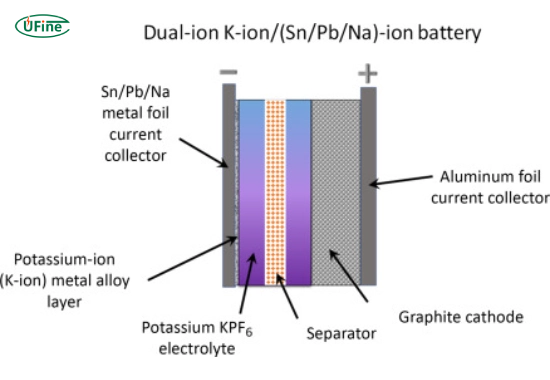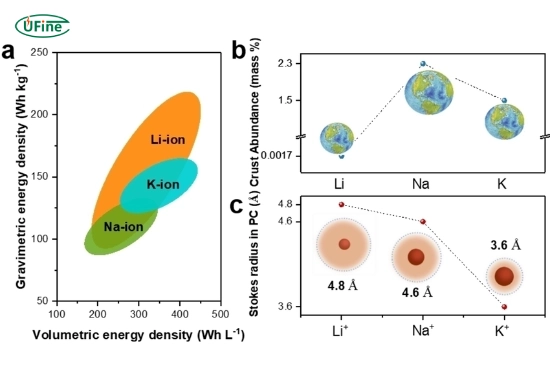As the world shifts to renewable energy and electric vehicles, batteries are key to this transformation. Lithium-ion batteries are widely discussed and have dominated the market for years. However, new contenders, like potassium-ion batteries, are emerging. These batteries offer a cost-effective and sustainable alternative. But how do their energy densities compare to lithium and sodium-ion batteries?
This article will explore potassium-ion batteries, their energy density, and how they compare to other technologies. We’ll also address common FAQs about this technology and its potential to revolutionize energy storage.
Part 1. What is a potassium-ion battery?
A potassium-ion battery is a rechargeable technology that uses potassium ions (K⁺) to transfer charge between the anode and cathode. Like lithium-ion and sodium-ion batteries, potassium-ion batteries store and release energy through ion movement.
Potassium-ion batteries stand out because they rely on abundant potassium, making them cheaper to produce than lithium-ion batteries.
Artikel Terkait: What Is a Potassium Ion Battery and How Does It Work?
Part 2. Why is energy density important in batteries?
Energy density refers to how much energy a battery can store per unit of weight or volume. It is essential because it determines how long a device will run on a single charge and how compact the battery can be.
For example:
- High energy density means lighter batteries with more power, ideal for electric vehicles (EVs) and portable electronics.
- Low energy density results in larger, heavier batteries, which may not be practical for mobile use.
Energy density is often a key factor in choosing the right battery for a specific application.
Part 3. How does the energy density of potassium-ion batteries compare to lithium-ion batteries?
Lithium-ion batteries have the highest energy density of all commercially available battery technologies. Their energy density ranges between 150 and 250 Wh/kg, depending on the chemistry and design.
Potassium-ion batteries are still being developed and have a lower energy density, around 100–150 Wh/kg. This is similar to early lithium-ion batteries but lower than modern lithium-ion cells.
The lower energy density of potassium-ion batteries is due to:
- Larger atomic size: Potassium ions are larger than lithium ions, limiting the number of ions that can fit into the electrode structure.
- Heavier components: Potassium-based materials often have a higher molecular weight, reducing the weight-to-energy ratio.
Part 4. How does the energy density of potassium-ion batteries compare to sodium-ion batteries?
Sodium-ion batteries are another emerging technology that competes with potassium-ion batteries. Their energy density typically ranges from 90–160 Wh/kg, which is slightly higher than potassium-ion batteries in some cases.
However, potassium-ion batteries have several advantages over sodium-ion batteries:
- Faster ion transport: Potassium ions move faster than sodium ions, leading to better charge and discharge rates.
- Better cycling stability: Potassium-ion batteries often last longer over more charge cycles.
- Higher voltage potential: Potassium ions can achieve higher operating voltages, helping offset the lower energy density.
Part 5. What are the advantages of potassium-ion batteries?
Despite having lower energy density, potassium-ion batteries offer several advantages:
- Abundant resources: Potassium is abundant and cheaper to source than lithium.
- Lower cost: Potassium-ion batteries use inexpensive materials, which reduces production costs.
- Environmental benefits: Potassium mining has a smaller ecological footprint compared to lithium extraction.
- Fast charging: Potassium ions move quickly, enabling faster charging times.
- Thermal stability: Potassium-ion batteries are less likely to overheat, reducing the risk of fires.
Part 6. What are the challenges facing potassium-ion batteries?
Despite their promise, potassium-ion batteries face several challenges:
- Lower energy density: Potassium-ion batteries have lower energy density than lithium-ion batteries, limiting their use in applications requiring compact, lightweight batteries.
- Electrode material limitations: A major challenge is finding electrode materials that efficiently host potassium ions.
- Shorter lifespan: Potassium-ion batteries have a shorter lifecycle compared to lithium-ion batteries.
- Lack of commercialization: Potassium-ion battery research is still experimental, with few products available.
Part 7. Key differences between potassium-ion, lithium-ion, and sodium-ion batteries
Potassium-ion, lithium-ion, and sodium-ion batteries each have strengths and weaknesses. Here’s a breakdown of the main differences:
- Energy density: Lithium-ion batteries have the highest energy density. Potassium-ion batteries range from 100–150 Wh/kg, lower than lithium-ion’s 150–250 Wh/kg.
- Cost: Potassium and sodium are more abundant and cheaper than lithium, making potassium-ion and sodium-ion batteries more affordable.
- Material availability: Lithium is limited, while potassium and sodium are widely available worldwide.
- Charging speed: Potassium ions move faster than sodium ions, giving potassium-ion batteries an edge in charging speed.
- Lifespan: Lithium-ion batteries last longer due to stable electrode materials. Potassium-ion and sodium-ion batteries are still improving in this area.
- Commercial availability: Lithium-ion batteries dominate the market, while potassium-ion and sodium-ion batteries are still developing.
Comparison Table
| Feature | Potassium-Ion Batteries | Lithium-Ion Batteries | Sodium-Ion Batteries |
|---|---|---|---|
| Energy Density | 100–150 Wh/kg | 150–250 Wh/kg | 90–160 Wh/kg |
| Cost | Low | High | Low |
| Material Availability | Very high | Limited | Very high |
| Charging Speed | Fast | Moderate | Moderate |
| Lifespan | Moderate | Long | Moderate |
| Thermal Stability | High | Moderate | High |
| Commercial Use | Limited | Widespread | Limited |
This table highlights the key differences, showing where each battery type excels. Potassium-ion batteries are affordable and sustainable, but improvements are needed in energy density and lifespan to compete with lithium-ion batteries. Sodium-ion batteries are similar but have slightly lower performance in some areas.
Part 8. What are the potential applications of potassium-ion batteries?
Potassium-ion batteries could be used in applications where cost and sustainability matter more than ultra-high energy density. Potential uses include:
- Grid storage: Potassium-ion batteries are ideal for renewable energy storage systems due to their affordability and stability.
- Low-cost electronics: Budget smartphones and other affordable devices could benefit from potassium-ion batteries.
- Agricultural equipment: Potassium-ion batteries may power machinery and irrigation systems in rural areas.
- Backup power systems: Their cost-effectiveness makes them suitable for backup power in homes and businesses.
Part 9. How can potassium-ion batteries improve in the future?
To compete with lithium-ion batteries, potassium-ion technology needs to overcome its current challenges. Key areas of improvement include:
- Enhancing electrode materials: Researchers are exploring new materials to boost energy density.
- Optimizing electrolytes: Advanced electrolytes can improve ion transport and performance.
- Scaling production: Large-scale manufacturing will reduce costs and increase availability.
- Improving lifecycle: Extending the lifespan of potassium-ion batteries will make them more competitive.
Part 10. FAQs
-
What is the energy density of potassium-ion batteries?
The energy density of potassium-ion batteries ranges from 100–150 Wh/kg, which is lower than that of lithium-ion batteries but comparable to that of sodium-ion batteries. -
Are potassium-ion batteries cheaper than lithium-ion batteries?
Potassium-ion batteries are generally cheaper due to the abundance of potassium and the lower cost of raw materials. -
Can potassium-ion batteries replace lithium-ion batteries?
Potassium-ion batteries are unlikely to replace lithium-ion batteries fully for high-performance applications but may become a viable alternative in cost-sensitive markets. -
What are the main advantages of potassium-ion batteries?
Potassium-ion batteries offer lower costs, faster charging speeds, and better environmental sustainability than lithium-ion batteries. -
Are potassium-ion batteries available on the market?
Potassium-ion batteries are still in the research and development stage, with limited commercial availability.
Related Tags:
More Articles

How to Choose the Best Floor Scrubber Battery for Commercial Cleaning?
Selecting the ideal floor scrubber battery ensures a long runtime, rapid charging, and minimal maintenance for efficient commercial cleaning operations.
Battery for Blower vs Battery for Leaf Vacuum: Which One Should You Choose?
Battery for blower vs leaf vacuum—learn the key differences in power, fit, and runtime to choose the right battery for your outdoor tool needs.
How to Choose the Right Battery for Blower?
Choosing the right blower battery? Consider voltage, capacity, chemistry & usage. This guide helps match the best battery for peak performance.
How to Choose the Best Insulated Battery Box for Lithium Batteries?
Choosing the Best Insulated Battery Box for Lithium Batteries? Discover key factors such as size, material, and safety for optimal protection and performance.
7 Critical Elements on a Lithium Battery Shipping Label
What must be on a lithium battery shipping label? Learn 7 key elements to ensure safety, legal compliance, and correct handling across all transport modes.






